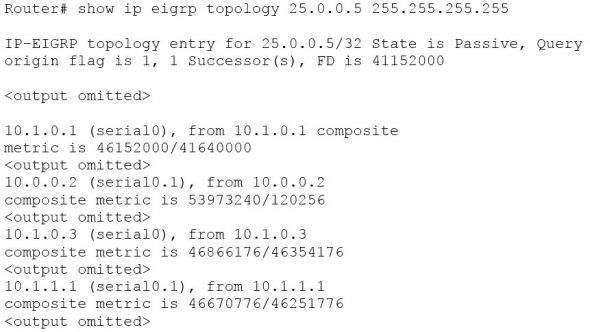Which Cisco Internetwork Operating System (IOS) command is used to view the number of Enhanced Interior Gateway Routing Protocol (EIGRP) packets that are sent and received?
A. show eigrp neighbors
B. show ip eigrp interfaces
C. show ip eigrp packets
D. show ip eigrp traffic
E. show ip route
F. show ip eigrp topology
Explanation:
The show ip eigrp traffic command is used to view the number of EIGRP packets that are sent and received. The syntax of the command is:
Router# show ip eigrp traffic [autonomous-system-number]
The autonomous-system-number parameter is optional. The output of the command is as follows:
Router# show ip eigrp traffic
IP-EIGRP Traffic Statistics for process 78
Hellos sent/received: 2180/2005
Updates sent/received: 70/21
Queries sent/received: 3/1
Replies sent/received: 0/3
Acks sent/received: 22/11
The show ip eigrp neighbors command is incorrect because it does not show the number of packets sent or received. It does show IP addresses of the devices with which the router has established an adjacency, as well as the retransmit interval and the queue count for each neighbor, as shown below:
Router# show ip eigrp neighbors
IP-EIGRP Neighbors for process 49
Address Interface Holdtime Uptime Q Seq SRTT RTO
(secs) (h:m:s) Count Num (ms) (ms)
146.89.81.28 Ethernet1 13 0:00:41 0 11 4 20
146.89.80.28 Ethernet0 12 0:02:01 0 10 12 24
146.89.80.31 Ethernet0 11 0:02:02 0 4 5 20
The show ip eigrp interfaces command is incorrect because this command is used to view information about the interfaces configured for EIGRP.
The show ip eigrp packets command is incorrect because it is not a valid Cisco IOS commands.
The show ip route command will not display EIGRP packets that are sent and received. It is used to view the routing table. When connectivity problems occur between subnets, this is the logical first command to execute. Routers must have routes to successfully send packets to remote subnets. Using this command is especially relevant when the underlying physical connection to the remote network has been verified as functional, but routing is still not occurring.
The show ip eigrp topology command is incorrect because it does not show the number of packets sent or received. This command displays all successor and feasible successor routes (if they exist) to each network. If you are interested in that information for only a specific destination network, you can specify that as shown in the output below. When you do, the command output displays all possible routes, including those that are not feasible successors:
In the above output, four routers are providing a route to the network specified in the command. However, only one of the submitted routes satisfies the feasibility test. This test dictates that to be a feasible successor, the advertised distance of the route must be less than the feasible distance of the current successor route.
The current successor route has a FD of 41152000, as shown in the first section of the output. In the values listed for each of the four submitted routes, the first number is the feasible distance and the second is the advertised distance. Only the route received from 10.0.0.2 (second section) with FD/AD values of 53973240/120256 satisfies this requirement, and thus this route is the only feasible successor route present in the topology table for the network specified in the command.
Objective:
Routing Fundamentals
Sub-Objective:
Configure, verify, and troubleshoot EIGRP for IPv4 (excluding authentication, filtering, manual summarization, redistribution, stub)
References:
Cisco > Cisco IOS IP Routing Protocols Command Reference > Routing Information Protocol Commands > show ip eigrp traffic


